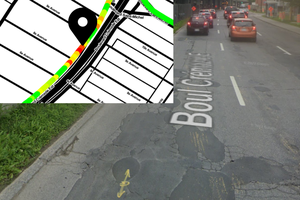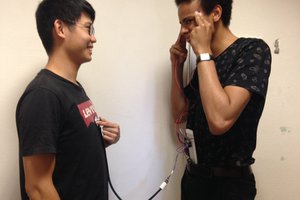DISCLAIMER: This project is in no way associated with Microsoft Research. Furthermore, there is no rigorous scientific evidence beyond anecdote that this concept is scientifically repeatable or useful. The primary current goal of this project is to develop the hardware, software and procedure necessary to test the hypothesis that haptic feedback applied to the wrist of an individual with tremors can dampen/diminish some of the impacts of Parkinsonian/Essential tremors.
A variety of approaches have been explored to help manage the impacts of neurological tremors that impact up to 1% of people worldwide (including individuals with essential and parkinsonian tremor). Invasive methods as well as pharmacological solutions show promise, but can be cost-prohibitive and not easily accessible. Mild electrical stimulation to a users arm, coupled with real-time tremor monitoring with an IMU has proven to be successful in reducing tremor severity by roughly 40%, but this requires applying electrical signals that can be uncomfortable. An approach that is similar to this but replaces electrical shock with simpe, surface haptic motor vibration (i.e. putting a tiny motor on top of a users nerves) was developed in 2017 and is commonly known as PROJECT EMMA. This was a research project that garnered great interest from the Parkinson’s community. As recently as December of 2022 the only known prototype to exist is the Emma Watch. The publically available information that exists is in the form of press releases and media coverage which suggests that there are tiny, coin cell motors inside of a watch band. These motors can be pressed against an individual’s wrist when they are experiencing a tremor. Some references in media coverage to “machine-learning” suggest there is an algorithmic process to determine a vibrational frequency pattern for these coin cell motors (as controlled by an accompanying tablet) that mitigates impacts from tremors. It appears in videos and press that while the watch doesn’t completely negate a tremor, it does allow Emma, the recipient, the ability to draw straight lines. The conceptual framework believed to be operating is that the surface vibration of the coin cell motors on the wrists “short-circuits” the brain so that it doesn’t send as strong of a correctional signal. In principle, the vibrating watch concept is not dissimilar to the commercially available TouchPoints product, which uses wrist mounted units to apply low, medium and strong vibrations as a means to mitigate stress. While no rigorous academic studies confirm their efficacy for Parkinson's patients, case studies published on the web portal for the product indicate potentially positive impacts on users. As of the initial publication of this project page (5/17/2023) there have been no published followup studies into this technology. The only formal, published research study that has been conducted into this type of intervention found that it was not effective for individuals with essential tremor. They found no clear correlation between motor vibration frequencies applied to a users arm and tremor frequencies. This finding informs the design of this work in several key ways: 1) Parkinsons and Essential tremors may have different underlying mechanisms - perhaps something is unique in Parkinsonian tremor that makes surface haptics more effective 2) longer term vibration patterns yield different results than shorter term - a device that is simple to use for long periods of time will allow for gathering more data in real-life situations 3) tremor severity may be impacted by anxiety and conditions of testing within a lab environment - a device that is unobtrusive and usable in everyday life can reveal different (and I would argue more helpful!) results when compared to tightly controlled laboratory data - solutions in the lab are great to inform research but mean nothing if they don't apply to real-world situations 4)...
Read more » Eric
Eric

 Peter Buczkowski
Peter Buczkowski
 Anthony I Stewart
Anthony I Stewart

 Soglz
Soglz
Hi, a beautiful project!
Are there any results from your study?